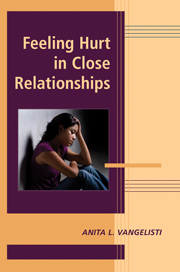Book contents
- Frontmatter
- Contents
- List of Contributors
- Foreword
- PART I INTRODUCTION
- PART II CONCEPTUALIZING HURT
- PART III HURTFUL ACTS
- PART IV HURT IN RELATIONAL CONTEXTS
- 12 Aggression and Victimization in Children's Peer Groups: A Relationship Perspective
- 13 Haven in a Heartless World? Hurt Feelings in the Family
- 14 Hurt Feelings in Adult Friendships
- 15 When Love Hurts: Understanding Hurtful Events in Couple Relationships
- 16 Hurt in Postdivorce Relationships
- PART V HURT IN APPLIED CONTEXTS
- Author Index
- Subject Index
- References
15 - When Love Hurts: Understanding Hurtful Events in Couple Relationships
from PART IV - HURT IN RELATIONAL CONTEXTS
Published online by Cambridge University Press: 04 August 2010
- Frontmatter
- Contents
- List of Contributors
- Foreword
- PART I INTRODUCTION
- PART II CONCEPTUALIZING HURT
- PART III HURTFUL ACTS
- PART IV HURT IN RELATIONAL CONTEXTS
- 12 Aggression and Victimization in Children's Peer Groups: A Relationship Perspective
- 13 Haven in a Heartless World? Hurt Feelings in the Family
- 14 Hurt Feelings in Adult Friendships
- 15 When Love Hurts: Understanding Hurtful Events in Couple Relationships
- 16 Hurt in Postdivorce Relationships
- PART V HURT IN APPLIED CONTEXTS
- Author Index
- Subject Index
- References
Summary
“Love is a battlefield,” “love hurts,” “love and other bruises”: Popular songs are replete with references to the pain that may be associated with romantic love. This chapter begins by outlining the particular importance of hurt feelings in couple relationships. It then addresses issues concerning the nature of hurtful events between intimate partners, the consequences of these events for victims and relationships, and the differing perceptions of victims and perpetrators. The final section presents avenues for further research and implications for practice.
WHY STUDY HURT IN COUPLE RELATIONSHIPS?
Researchers and lay people alike agree that personal relationships are crucial to physical and psychological well-being (e.g., Baumeister & Leary, 1995). Of particular importance in this regard are couple (“romantic”) relationships. These relationships are fundamental to the structure of society and play a unique role in meeting individuals' needs for comfort, companionship, support, and security (Argyle, 1986; Weiss, 1991).
Although terms such as “comfort” and “support” imply positive affect, romantic partners' unique role as a source and target of strong emotion is a double-edged sword – as many song titles suggest, “love” often entails “hurt.” The early stages of couple relationships involve considerable relational uncertainty, as partners know little about each other's hopes, intentions, and weaknesses. At the same time, they may experience intense physical attraction and the related features of physiological arousal, together with concerns about the extent to which these feelings are reciprocated (Hazan & Zeifman, 1999).
- Type
- Chapter
- Information
- Feeling Hurt in Close Relationships , pp. 313 - 335Publisher: Cambridge University PressPrint publication year: 2009
References
- 4
- Cited by



